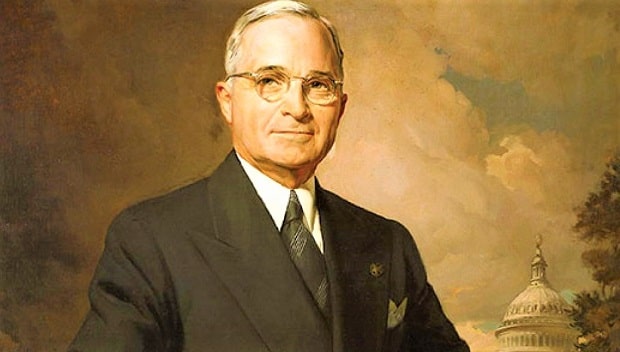Harry S. Truman (Lamar, 8 of May of 1884 – Kansas City, 26 of December of 1972) was the 33rd president of the United States. The last mate running of Franklin D. Roosevelt in 1944, Truman became president on 12 April 1945 after the death of Roosevelt. In his presidency, the USA ended World War II; tension with the Soviet Union grew after the conflict, starting the Cold War.
Harry S. Truman was born in Missouri, spending most of his childhood on the family farm. During the First World War, he served in France with the National Guard as an artillery officer. After the war, Truman owned a haberdashery before joining the Democratic Party.
His first public post was that of a county officer, and in 1934 he was elected United States Senator. He gained national prominence when he headed the Truman Committee, which exposed spending, fraud, and corruption in government war contracts.
Although Nazi Germany surrendered a few weeks after Truman assumed the presidency, the war against Japan was expected to last another year. His decision to use nuclear weapons against Japan accelerated the end of the conflict, but it remains controversial today.
His presidency was a turning point in foreign relations, with the United States supporting an internationalist policy together with its European allies. Working closely with the Congress, Truman helped the foundation of the United Nations, issued the Truman Doctrine against communism, and approved the Marshall Plan of US $12 billion to rebuild Europe.
The alliance with the Soviet Union during the war turned into opposition in times of peace. He oversaw the Berlin Airlift in 1948 and the creation of NATO in 1949. When communist North Korea invaded South Korea in 1950, Truman immediately sent US troops and obtained UN support to start the Korean War.
After initial success, UN forces were repelled by Chinese intervention and the conflict was at a standstill during the last years of his presidency.
Accusations of corruption in his administration, which was linked to some members of his White House cabinet, were the main point of discussion in the 1952 presidential election, in which Adlai Stevenson II, Truman’s successor as a Democratic candidate, was defeated by Dwight D Eisenhower.
Popular and academic assessments of his presidency were initially negative but ended up becoming more positive after Truman retired from politics. He passed away in December 1972 in Kansas City.
The Early Life of Harry S. Truman
Harry S. Truman was born on May 8, 1884, in Lamar, Missouri. He came from a very simple background; his father John Anderson Truman (1851-1914) was a farmer, his mother Martha Ellen Young Truman (1852-1947) was a housewife. Harry was Truman’s first child, followed by a brother and sister. He was English, Scottish and Irish ancestors.
The “S” in Harry S. Truman is not an abbreviation for a middle name, but an initiative that comes from the names of his two grandfathers (Anderson Shipp Truman and Solomon Young); a common way of remembering one’s ancestors in the south of the United States at the time.
Since Truman’s parents could not decide if they should choose the middle name Shipp or Solomon, they merely used the initial. Although the “S” is not an abbreviation, Truman put a point behind it.
In 1890 the Truman family settled in Independence, a few kilometers away, where Harry attended high school. He successfully completed this in 1901. He then went to a commercial school for a short time but returned to his parents after a short time when his father lost his entire fortune in wheat speculation.
Political Career Beginnings
Already in the first half of the 1910s, Harry S. Truman became more interested in politics. President Woodrow Wilson’s enthusiasm for progressive politics soon brought him to the Democratic Party. His political interest and the President’s support was one of Truman’s main reasons to enlist in the army.
Supported by Tom Pendergast, the most influential Democrat member of Kansas City at the time, Truman became the Judge of the County Court of Jackson County in 1922 after his business failed. Truman and Pendergast got to know each other during his career in the army after Pendergast’s nephew had served with Truman.
In addition to Pendergast, he owed his choice above all to his fame as a captain in the First World War; he was able to rely on the support of former comrades, many of whom he knew personally from the region. After the two-year term in which he was primarily responsible for administrative activities, he was not re-elected in 1924 in view of the strong trends towards the Republican Party. Afterward, he worked again on the family farm for two years.
In late 1926, Truman was elected Presiding Judge by Jackson County. Both his popularity as a former captain and Tom Pendergast helped him with this election success. Although the literal translation into German would be “Presiding Judge”, it was not a legal activity.

